
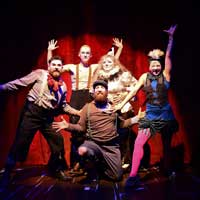 Recommended *** If you prefer watching the tragic rather than the magic of Christmas, then “Burning Bluebeard”, written by Jay Torrence and directed by Halena Kays, is sure to ignite your interest. Funny, macabre, and frightfully delightful, the performance tells the story of the inferno at the Iroquois Theater, in Chicago, during the Wednesday matinee of “Bluebeard”, a children’s show playing on December 30, 1903. The modern retelling is largely a prologue to the second act of the original musical, where audience members were caught in an electrical fire followed by a stampede, and then burned alive.
Recommended *** If you prefer watching the tragic rather than the magic of Christmas, then “Burning Bluebeard”, written by Jay Torrence and directed by Halena Kays, is sure to ignite your interest. Funny, macabre, and frightfully delightful, the performance tells the story of the inferno at the Iroquois Theater, in Chicago, during the Wednesday matinee of “Bluebeard”, a children’s show playing on December 30, 1903. The modern retelling is largely a prologue to the second act of the original musical, where audience members were caught in an electrical fire followed by a stampede, and then burned alive.
The original “Bluebeard” was a tawdry English show that had been an annual Christmas classic at the turn of the 19th/20th century. The first act was so bad that nine songs were needed to cover for such a poorly written script. Some element was needed to infuse excitement into such a boring tale. Nothing like a spectacular blaze! It was in the second act when the descent of a prop moon created sparks that literally brought down the house. And the glamorous and glitzy new theater was soon to be no more.
If you’ve grown up in Chicago, some relative or acquaintance has probably told you about this horrifying incident at some point in your life—and you might have been curious about exactly what had happened on that fateful day. The characters in the performance shine a spotlight on an event that took place 116 years ago, and now you see it upfront and personal.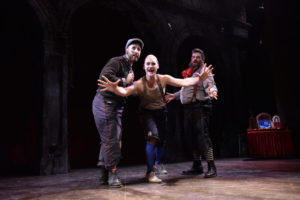
The action is initially set in the contemporary time period (which shifts from the 1960s to the immediate present to all the years in between). Each of the characters seems to have a terrific insight: picking out uncomfortable emotions within the audience that we may not normally admit to ourselves, namely, our fascination with death and horrific tragedy. Why else would we want to attend a play about dying theatregoers? That said, the beginning of the show is easy, almost fun, with all the dancers on stage and the lovely piano music. Then there is some preoccupation as to whether there is some possibility of an alternate timeline where such a catastrophic event will not happen. Can some simple action be taken that could alter history? However, we are also told that the theater was a death trap, and so we can only wait nervously until the inevitable happens: when the characters act the parts of those who had once graced the Iroquois stage.
We delight in being entertained by the vaudevillian troupe. Leah Urzendowski is amazing as Nellie Reed. She is bold, brash, and authentic, and the stage lights up whether she takes charge. She explains her life history of wanting so badly to move from her small rural town to the big city lights of Chicago and become an acrobat. Equally forceful and dynamic is Pamela Chermansky, who gives an extraordinary performance as the Fancy Clown, who cajoles and lectures us. Ryan Walters plays Eddie Foy, the comic actor who had once told the original attendees to calm down and stay seated; everybody looked to him for guidance when the fire first began. He insisted that the fire curtain would come down; but instead, it got stuck: on who knows what? With people screaming, clawing, and begging in the aisles, you can imagine his guilt for not demanding that people immediately leave the theater. Anthony Courser (Henry Gilfoil) is the actor who recreates Bluebeard, while Jay Torrence (Robert Murray/Playwright) explains how his role was that of the backstage manager, one of the first to know that the odd lighting was not a special effect. Crosby Sandoval, as the Faerie Queen, is the only fantastical character who, both in the present-day and the past, does not utter a single word. 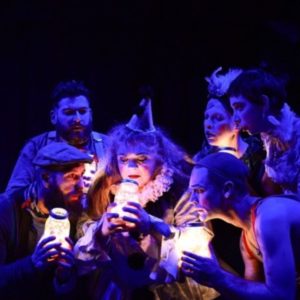
Compelling dances superbly capture each of the character’s rapturous joy in performing on stage before an audience; these dances also telescope the agony and horror of the unmitigated disaster. Choreographer Ariel Etanna Triunfo deserves high praise for the expressive physical movements that bring out important features of the plot. If there is any one reason to see this production, it is for the quality of the dance.
Especially thematic is Maggie Fullilove-Nugent’s lighting design. The glowing lanterns with bright bulbs inside represent the illumination of the performing arts and signify the fire within the audience. The barebone lightbulbs with their glowing filaments, strategically located on the ceiling throughout the house, are a throwback to Edison’s original design from that time period. Yet the lighting should have been handled with somewhat more flare/flair. For example, an effect disc should have been rotated in front of a projector to create the image of flames; likewise, some of the lights should have flickered to demonstrate a failing electrical system and create more tension in the audience. Some cascading light effects should have represented the falling embers. That said, the glowing red that later took over the stage was done to perfection as was the theatrical haze at the end of the scene to represent the smoke in the theater and the overwhelming devastation.
The well-crafted set by Jeffrey D. Kmiec blurs the various timelines. Old, charred marks serve to simultaneously represent the remains of a vintage theater; it is also a modern throwback to the stage where an old-fashioned performance would have been held. That said, a bit of the glossy glitziness of the original Iroquois Theater could have been preserved with mirrors as rolling props to portray the edifice’s glamor and its destruction, as well as to create the illusion of a set change.
Robert Hornbostel’s sound design was wonderful. From old recordings that simulated those of a bygone era, to the canned yelling and screaming of those blocked inside the theater, to the music that accompanied each of the dance numbers, the sound was fluid, even, and engaging. Costumes by Bill Morey and Lizzie Bracken appropriately bring back memories of how vaudeville stars would have dressed in that era.
Narration allows us to imagine the Chicago of that time period: the trolley strike, the unpaved streets filled with wanton horse-drawn wagons, the grittiness and rawness of the city with its brothels and its bars, the shooting of laborers who 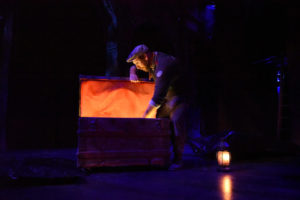 wanted to form unions, and, of course, the lack of safety codes in downtown buildings. This was an era of unfettered capitalism with Chicago as its epicenter. It was indeed the city that had risen up from the ashes of the great fire of 1871.
wanted to form unions, and, of course, the lack of safety codes in downtown buildings. This was an era of unfettered capitalism with Chicago as its epicenter. It was indeed the city that had risen up from the ashes of the great fire of 1871.
The Iroquois Theater fire killed over 600 people and injured over 250. For those who had lived through the conflagration or had read about it in the newspapers of that period, this event brought back haunting memories of 1871. It predated the Triangle Shirtwaist Factory fire in New York City by over seven years. The second calamity left 146 dead; there too the building’s occupants had little or no means of escape. Was nothing learned in the interim? Why did it have to take another tragic fire to teach everybody the important lesson of preserving and protecting human life?
“Burning Bluebeard” shows us what can happen when safety standards are ignored in building construction and maintenance. In 1903, there were no exit signs in the theater. Black curtains hid inward opening exit doors. There were many blocked exits, especially those preventing the poorer patrons in the upper balcony from gaining access to the more expensive seats on the lower level. The theater was severely overcrowded during that ill-fated afternoon, with people standing shoulder-to-shoulder in the balcony. If there was any silver lining in that horrible cremation cloud, it was that laws and ordinances were subsequently enacted to improve fire safety. Today there must be limitations on the capacity of rooms and auditoriums. Signs about occupancy must be prominently displayed. Lit exit signs must be present in every theater to demarcate the egress. Exit doors must open outward and cannot be obstructed. There has to be a working sprinkler system. Building inspections must be taken seriously and fire codes enforced.
In all, the performance conjures up a blaze of conflicting emotions and is the perfect antidote to sugary holiday faire. But if you’ve ever been in a fire or have had loved ones killed or injured in a fire or some similar catastrophe, this show will give you nightmares. The sheer terror of the scene lives in your subconscious. So while the play is built on a noteworthy historical event and offers a fascinating premise, watching it may not work for you. For me, it brought back shades of 9/11, and that was very disturbing. But if you enjoy dark and irreverent humor—and can get past the incendiary puns, the trivialization of tragedy, and the continual references to death and critical injury—then you will get a good laugh and will most certainly enjoy yourself.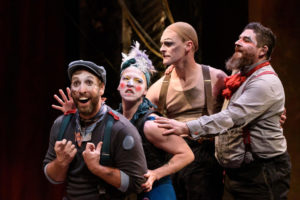
The Ruffians’ production of “Burning Bluebeard” is playing at the Porchlight Music Theatre through December 27, 2019, at the Ruth Page Center for the Arts, 1016 N. Dearborn Street, Chicago.
The performance schedule is as follows:
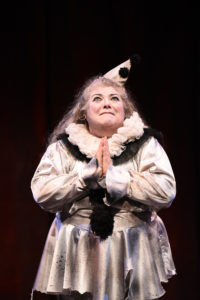 Thursday, Dec. 19 at 7:30 p.m.
Thursday, Dec. 19 at 7:30 p.m.
Friday, Dec. 20 at 8:00 p.m.
Saturday, Dec. 21 at 3:30 and 8:00 p.m.
Sunday, Dec. 22 at 2:00 p.m.
Thursday, Dec. 26 at 1:30 and 7:30 p.m.
Friday, Dec 27 at 3:30 p.m. and 8:00 p.m.
Tickets are $45 and are on sale now at the Porchlight Music Theatre box office, 773-777-9884, or on-line at PorchlightMusicTheatre.org.
To see what others are saying, visit http://www.theatreinchicago.com, go to Review Round-Up and click at “Burning Bluebeard”.






More Stories
“Dead Man’s Cell Phone”
“the distrikt of lake michigun”
“Mother Courage and Her Children” reviewed by Jacob Davis